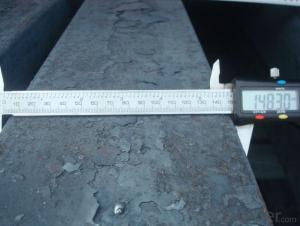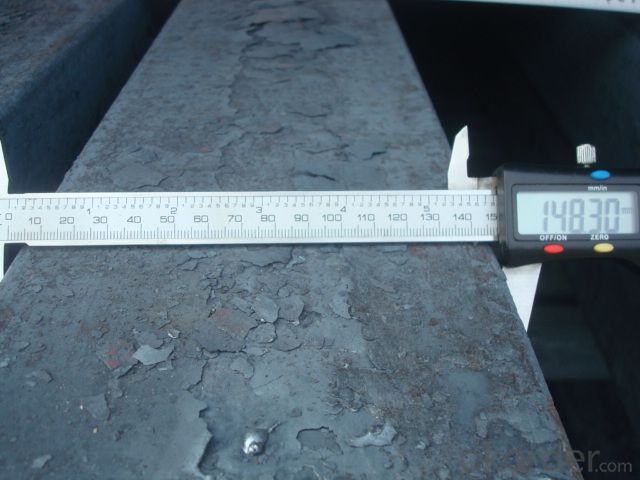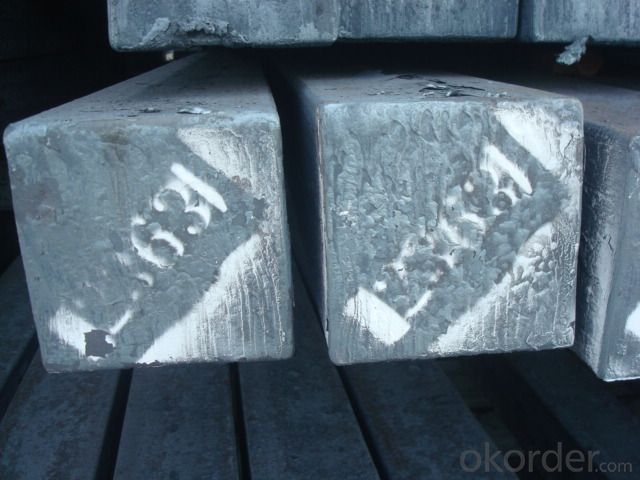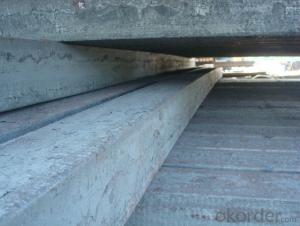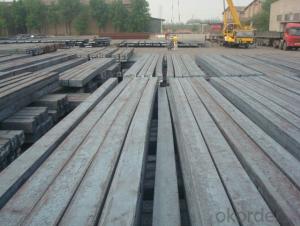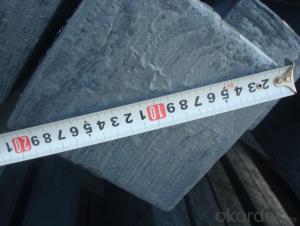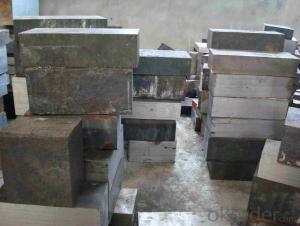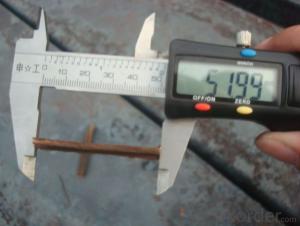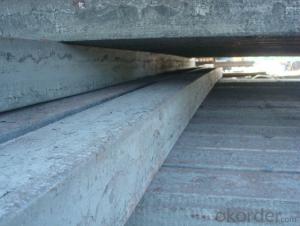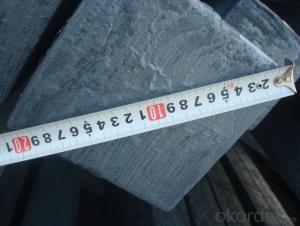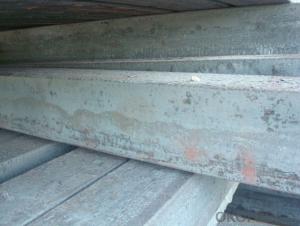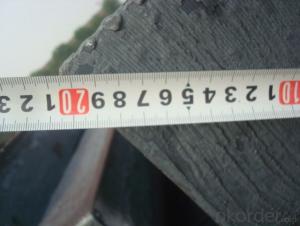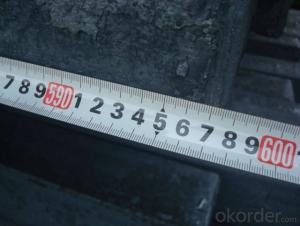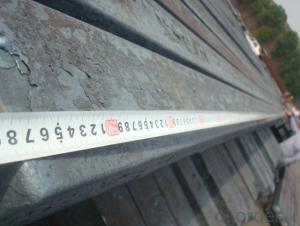Alloyed Continue Casting Steel Bloom by Blast Furnace
- Loading Port:
- Tianjin
- Payment Terms:
- TT OR LC
- Min Order Qty:
- 1000 m.t.
- Supply Capability:
- 10000 m.t./month
OKorder Service Pledge
OKorder Financial Service
You Might Also Like
Alloyed Steel Bloom by Blast Furnace with Chromium
1.Structure of Alloyed Steel Bloom by Blast Furnace with Chromium
Steel Blooms Manufactured by Continue Casting is the raw material of all kinds of steel mill. Bloom section of square, round, flat, rectangular and abnormity, etc Several, mainly related to shape of rolled products. Simple rolled section steel, choose cross section of square Bloom or rectangular Bloom. rolling The sector products such as flat steel, Angle steel, select the rectangular Bloom or slab. Had better profiled Bloom when production beams, channels, and in rolling process Lines and improve the yield. The raw material of round Bloom is the production of seamless tube.
2.Main Features of Alloyed Steel Bloom by Blast Furnace with Chromium.
Steel Blooms Manufactured by Continue Casting section size should meet the requirements of rolling deformation and finished product quality, but also roll strength and biting condition of restrictions. General steel Bloom section height H. And the roll diameter D The ratio of the ( namely H/D) Should be less than or equal to zero 0.5 . Length of steel Bloom by finishing temperature, Rolling time and the length of the product Or times ruler. When heated too long accident prone to bump the furnace wall of steel, too short, furnace bottom utilization rate is not high, influence the heating furnace production. For the production Choose a variety of steel and steel Bloom, should consider the affinities of Bloom, as far as possible in order to improve the productivity of the roughing mill, simplify the stock management of workshop.
There are three shapes of the steel Blooms: square Bloom, slab, rectangular Bloom The Chinese Bloom, rectangular Bloom is mainly suitable for rolling hot rolled strip, building reinforced bar, Ordinary wire, high speed wire rod and various small profile. Of the slab are mainly used for rolling plate and hot coil sheet.
3. Alloyed Steel Bloom by Blast Furnace with Chromium Images
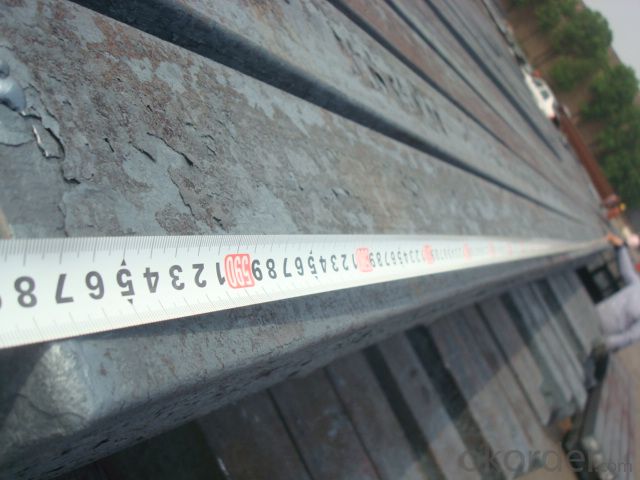
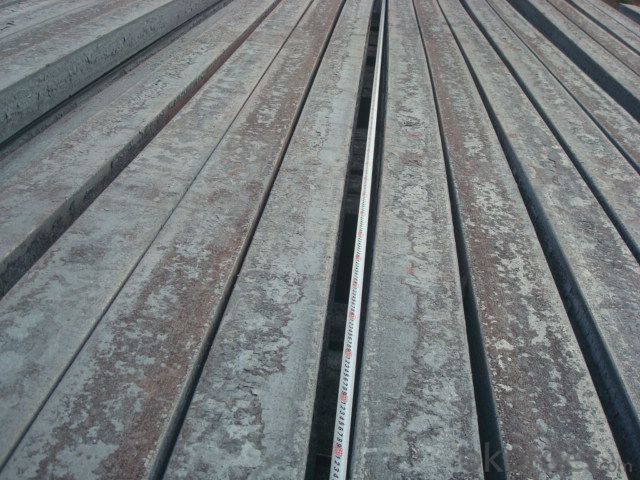
4. Alloyed Steel Bloom by Blast Furnace with Chromium Specification
Steel Bloom by Blast Furnace with Chromium rolled steel, after processing can be used for mechanical parts, forging parts, processing all kinds of steel, steel Q345B channel steel, wire rod is the role of the Bloom. Steel Bloom is used in the production of semi-finished products, generally cannot be used directly for the society. Steel Blooms and steel are strictly divided into standard, cannot decide to whether the business enterprise of the final product, and according to unified standards to perform the whole society. Typically, Bloom and the steel is relatively easy to distinguish, but for some steel Bloom, and have the same specification and same steel purposes (such as rolling tube Bloom), whether can be used for other industries, whether through steel processing process, whether through a finished product rolling mill processing to distinguish
Material standard The editor Range of thickness: 150-240 - mm + / - 5 mm width range: 880-1530 - mm + / - 20 mm Length: 3700-10000 - mm + / - 500 - mm Cross-sectional size: 64 * 64; 82 * 82; 98 * 98; 124 * 124; 120 * 150; 152 * 164; 152 * 170 mm Length: 9000 mm Section of tolerance: Bloom: 1.0 + / - 2.0-1.0 + / - 1.0 mm slab: width: + / - 2.0 mm thickness: + / - 3.0 mm The length tolerance: + / - 200 mm Section diagonal tolerance: 3.5-8.0 MM Bloom section size protrusions requirements: < 1242 mm, do not allow; > = 1242 mm, < = 2 mm 1242 mm, < = 3 mm Beheading (shear) extension deformation: < 1242 mm Bloom: no control; The slab: < = 15 mm Surface tilt: no more than Bloom section 0.1 Bending: every 1 m length is not more than 10 mm The distortion: length < = 5 m, < = 11. ; The length of the < = 7.5 M, < = 5. Material % 3 sp/PS chemical composition: C Mn Si S P
5.FAQ of Alloyed Continue Casting Steel Bloom by Blast Furnace
We have organized several common questions for our clients,may help you sincerely:
①How about your company?
A world class manufacturer & supplier of castings forging in carbon steel and alloy steel,is one of the large-scale professional investment casting production bases in China,consisting of both casting foundry forging and machining factory. Annually more than 8000 tons Precision casting and forging parts are exported to markets in Europe,America and Japan. OEM casting and forging service available according to customer’s requirements.
②How to guarantee the quality of the products?
We have established the international advanced quality management system,every link from raw material to final product we have strict quality test;We resolutely put an end to unqualified products flowing into the market. At the same time, we will provide necessary follow-up service assurance.
③How is the packaging and delivery?
Exporting Package with the steel material cover and the delivery term is based on the project.
- Q: What are the international standards for steel billets?
- The international standards for steel billets are defined by organizations such as the International Organization for Standardization (ISO) and the American Society for Testing and Materials (ASTM). These standards typically encompass various aspects including chemical composition, mechanical properties, dimensions, tolerances, and surface quality, ensuring consistency and quality across different countries and manufacturers.
- Q: How is the demand for steel billets projected to change in the future?
- The demand for steel billets is expected to increase in the future due to the growing infrastructure development, urbanization, and industrialization across various regions. Additionally, the automotive and manufacturing sectors are anticipated to drive the demand for steel billets as they continue to expand. Overall, the future outlook for the demand of steel billets is positive and is expected to witness a steady rise.
- Q: How do steel billets contribute to the strength of a structure?
- Steel billets contribute to the strength of a structure by providing a high-strength, durable material that can withstand heavy loads and stress. Due to their composition and manufacturing process, steel billets offer superior strength and structural integrity, making them ideal for use in construction projects. They can be shaped and formed into various structural components, such as beams, columns, and reinforcement bars, which enhance the overall stability and load-bearing capacity of a structure. Additionally, the uniformity and consistency of steel billets ensure that the strength of the structure remains consistent throughout, further enhancing its overall strength and reliability.
- Q: Are steel billets used in the shipbuilding industry?
- Steel billets are commonly utilized in the shipbuilding industry. They serve as semi-finished steel products, usually employed as raw materials for further processing. Within shipbuilding, these billets find application in the production of diverse structural components, including plates, beams, and bars, which constitute the ship's framework. The remarkable strength and durability of steel deem it an optimal material for ship construction, capable of enduring the challenging conditions of the marine environment. Moreover, steel billets possess the advantage of being easily molded and welded, facilitating the fabrication of intricate ship structures. Overall, the pivotal role played by steel billets in the shipbuilding sector revolves around supplying the essential raw materials necessary for constructing robust and dependable vessels.
- Q: How do steel billets contribute to the overall strength of a finished product?
- Steel billets contribute to the overall strength of a finished product by providing a solid and dense starting material. Due to their high carbon content and precise manufacturing process, steel billets offer superior mechanical properties, such as hardness and tensile strength. These attributes enable the billets to withstand heavy loads and resist deformation, ensuring that the final product possesses the necessary strength and durability.
- Q: How do steel billets contribute to the overall recyclability of a structure?
- Steel billets contribute to the overall recyclability of a structure because they can be easily melted down and reused in the production of new steel products. This reduces the need for raw materials and energy consumption, making the structure more environmentally sustainable. Additionally, the recycling process for steel billets is cost-effective, making it a viable option for manufacturers and builders.
- Q: What are the potential applications of steel billets in the packaging aftermarket?
- Steel billets have numerous potential applications in the packaging aftermarket due to their strength, durability, and versatility. Some of the potential applications include: 1. Metal packaging: Steel billets can be used to create metal packaging containers such as cans, drums, and barrels. These containers provide excellent protection for various products, especially those that require high strength and durability, such as hazardous materials or heavy machinery parts. 2. Pallets and crates: Steel billets can be used to manufacture sturdy pallets and crates for packaging and transporting goods. These steel-based pallets and crates offer superior load-bearing capacity and can withstand rough handling, making them ideal for heavy or fragile items that need extra protection during transit. 3. Strapping and binding: Steel billets can be processed into steel strapping, which is commonly used for binding and securing packages together. Steel strapping provides exceptional strength and resistance to breakage, making it suitable for securing heavy or bulky items during transportation or storage. 4. Protective corners and edges: Steel billets can be shaped into protective corners and edges to reinforce packaging materials, such as cardboard boxes or wooden crates. These steel reinforcements enhance the structural integrity of the packaging, preventing damage and ensuring that the contents remain intact during transit. 5. Industrial packaging solutions: Steel billets can be utilized in the development of specialized packaging solutions for industrial applications. For example, steel billets can be used to create custom-made containers, racks, or frames that are specifically designed to safely store and transport large machinery parts, equipment, or industrial components. Overall, the potential applications of steel billets in the packaging aftermarket are vast. Their strength, durability, and versatility make them a valuable material for creating packaging solutions that can withstand the demands of various industries and ensure the safe and secure transportation of goods.
- Q: What are the potential applications of steel billets in the automotive sector?
- Steel billets have a wide range of potential applications in the automotive sector due to their strength, durability, and versatility. They can be used to manufacture various automotive components such as engine parts, chassis, suspension systems, and transmission components. Additionally, steel billets can be shaped and formed into different sizes and shapes to meet the specific requirements of automotive manufacturers. Overall, their potential applications in the automotive sector contribute to the production of safer, more efficient, and reliable vehicles.
- Q: What are the potential risks associated with steel billet production?
- Steel billet production carries various potential risks. To begin with, the production process involves working with high temperatures and molten metal, which can lead to burns and fire hazards. Operators and workers must exercise caution when handling the equipment and ensure they follow proper safety protocols to prevent accidents. Moreover, the raw materials used in steel billet production, such as iron ore and coal, may contain impurities that can release harmful gases and particulate matter during production. If not controlled and mitigated effectively, these emissions can pose health risks to workers and nearby communities. In addition, the machinery and equipment utilized in steel billet production, including furnaces and rolling mills, can pose mechanical hazards if not adequately maintained or operated. Accidents resulting from equipment malfunctions or material failures can cause injuries to workers and damage to the production facility. Furthermore, the steel industry heavily relies on non-renewable energy sources, such as electricity and fossil fuels, which contribute to greenhouse gas emissions and climate change. It is essential to minimize the environmental impact by implementing energy-efficient practices and adopting cleaner technologies. Lastly, transporting steel billets from the production facility to the next stage in the supply chain presents risks. Proper lifting and securing techniques are necessary to prevent accidents and injuries during loading, unloading, and transportation of the heavy steel billets. To address these risks, steel billet producers must prioritize safety measures. This includes conducting regular equipment inspections, providing proper training for workers, implementing environmental controls, adhering to safety regulations, and continuously improving operational practices.
- Q: What are the physical properties of steel billets?
- Steel billets have several physical properties including high strength, excellent toughness, good ductility, and high resistance to corrosion. They are typically solid, dense, and have a metallic luster. Steel billets are also known for their high melting point and conductivity, making them suitable for various industrial applications such as construction, automotive, and manufacturing.
Send your message to us
Alloyed Continue Casting Steel Bloom by Blast Furnace
- Loading Port:
- Tianjin
- Payment Terms:
- TT OR LC
- Min Order Qty:
- 1000 m.t.
- Supply Capability:
- 10000 m.t./month
OKorder Service Pledge
OKorder Financial Service
Similar products
Hot products
Hot Searches
Related keywords
